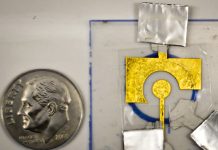
A plain-looking chunk of bone and teeth has led scientists to a surprising discovery about a large prehistoric cat that once roamed Texas.
This fossil, which looks like an unremarkable rock, has helped researchers understand more about the saber-tooth cat known as Homotherium.
John Moretti, a doctoral student at the University of Texas at Austin, was the lead author of the study published in The Anatomical Record. He described the fossil as “ugly on the outside,” but valuable inside, much like a geode.
The fossil, resembling a lumpy, rounded rock with some worn-out teeth, had been tumbled and submerged in the Gulf of Mexico for thousands of years before it washed up on a beach.
The real surprise came when the fossil was X-rayed at the University of Texas Computed Tomography Lab. Inside the fossil, Moretti discovered a hidden canine tooth that had not yet erupted from the jawbone.
This hidden tooth was crucial for identifying the fossil as belonging to a Homotherium.
Homotherium was a large cat that lived across Africa, Eurasia, and the Americas for millions of years.
This specific cat wasn’t fully grown when it died, so its saber-like tooth hadn’t fully emerged yet.
Moretti explained that if the tooth had fully grown, it might have broken off, leaving them without the evidence needed for identification.
Homotherium was about the size of a jaguar, with an elongated face, long front legs, and a sloping back ending in a bobtail.
The cat’s distinctive serrated teeth were covered by large gum flaps, similar to those of domestic dogs today.
Fossils of Homotherium have been found in various parts of Texas before, but this fossil is the first to show that the big cat also lived on the now-submerged continental shelf connecting Texas and Florida.
Scientists believe this land was a humid grassland corridor that animals like capybaras and giant armadillos used to travel from Mexico to Texas and Florida.
The discovery provides insight into the ecology of this region during the Late Pleistocene era. Big carnivores like Homotherium played a significant role in shaping the animal community by controlling prey populations and influencing biodiversity.
The fossil was discovered over 60 years ago on McFaddin Beach by Russell Long, a professor at Lamar University.
It was later donated by Brian Babin, a US Congressman and former student of Long’s, who worked as a dentist for 38 years. Babin’s background in paleontology and dentistry helped him recognize the fossil’s significance.
This research is part of a larger project on McFaddin Beach fossils that began in 2018, involving UT Austin, Sam Houston State University, and North Carolina State University.



